In eight years of living in Azerbaijan, I have been to my fair share of weddings. These are a beautiful opportunity to learn about customs, but they can be a mystery to the novice attendee. It took me a half dozen tries (and as many cultural foibles) before I understood what was going on well enough to really enjoy the event. When a colleague invited me to his wedding in Qazakh in November, I decided this would be a good opportunity to document what I have learned from my mistakes so far.
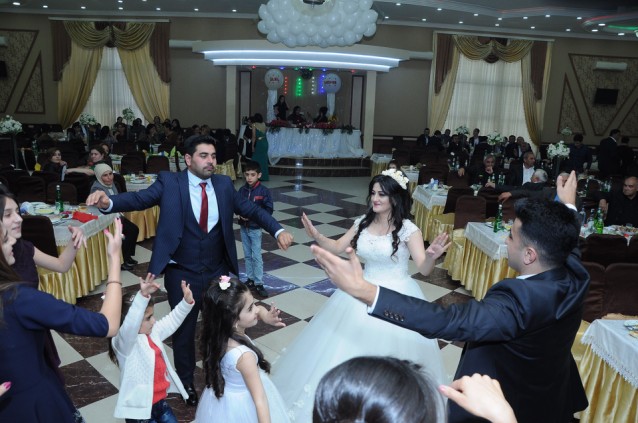 The bride and groom (red tie) take a break from sitting at the head table (background) to dance with relatives. Photo: courtesy of Shamil Muradli
The bride and groom (red tie) take a break from sitting at the head table (background) to dance with relatives. Photo: courtesy of Shamil Muradli
1. Know your venue
When I heard that my colleague’s wedding would be in Qazakh, I immediately wondered: will it be in a restaurant or a tent? Weddings in Azerbaijan come in two main varieties. Most urban weddings are held in a shadliq sarayi, literally “palace of happiness,” a large rented hall with full food service. But in rural areas, the family butchers and cooks all their own food, and hundreds of people sit at rented picnic tables under a long tent in the backyard. Both types of events include crowds of people dancing to booming music, an emcee with a microphone on maximum reverb so his introductions have an epic sort of echo, and many courses of steaming dishes.
If you find yourself with a wedding invitation, take a minute to understand the venue. (I learned this lesson the hard way in Beylaqan once when I showed up in serious high heels, only to end up tripping repeatedly over machete-chopped corn stalk stubble because the dance floor was in a field.)
This wedding in Qazakh could fit into both of the categories above: as often happens in regional centres, the party was held in a rented wedding hall, but the meal was cooked and catered by the family. That was a fortunate twist, because I was able to wear my heels without fear but also had the chance to observe the food preparation process at the groom’s home.
2. Understand which wedding
My colleague’s wedding was an oghlan toyu, or “boy wedding.” Weddings can sometimes be a combined affair hosted by the bride’s and groom’s families, but often each side will organize its own event, with the qiz toyu (“girl wedding”) a week or so before the oghlan toyu. One early wedding-goer mistake I made was to embarrass family members by asking naïve questions about when the bride would go home with the groom. Just so you know: the marriage isn’t consummated until the night after the oghlan toyu.
At the qiz toyu, the bride wears a brightly-coloured dress (often red or pink) and dances joyfully with her family and friends along with a few representatives of the groom’s close family who attend. At the oghlan toyu, the bride wears white and rarely smiles out of a sense of propriety and honour. A small delegation from her family attends, but for them this can be a sombre occasion. I’ve seen mothers crying as they see their daughters off at the end of the night. In many village families, this rite of passage when the bride moves in with the groom’s family is the first time she has ever gone to live outside her parents’ home.
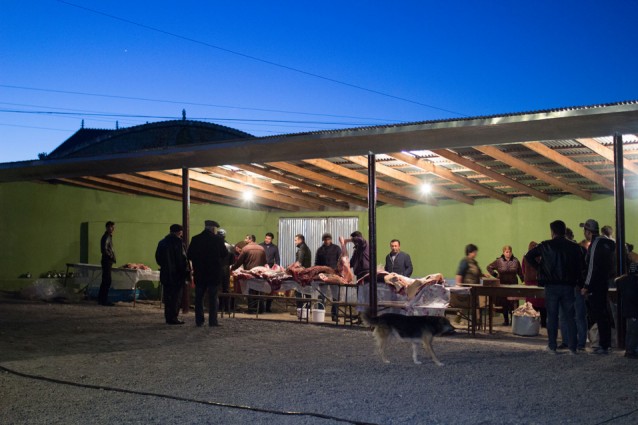 The groom’s family butchers animals the day before the wedding at their home in Qazakh. Photo: Tom Marsden
The groom’s family butchers animals the day before the wedding at their home in Qazakh. Photo: Tom Marsden
3. Prepare to eat... entrails
the internal organs must be eaten quickly, so they become the feast for the volunteer force
We arrived at the groom’s house in Qazakh one day before the wedding. In villages, the wedding eve is a party in its own right, as dozens of community members gather to help cook for the event. Then they have dinner together. This evening is appetizingly named jiyar/ichalat akhshami (liver/entrails evening) after the featured dish of the night. Eating liver is a practical choice: before the wedding, dozens of animals are slaughtered and dressed. In the absence of a huge quantity of refrigeration, the internal organs must be eaten quickly, so they become the feast for the volunteer force.
This day was entirely dedicated to food preparation in expectation of around 400 wedding guests. We saw women chopping vegetables and cooking 700 crepes. Meanwhile the men did an immense amount of butchering. They had slaughtered two cows, 10 sheep, and 80 chickens. These were all in various stages of dismemberment across tables in the yard, being cut into kebab-sized pieces. As night fell, they all took a break as we sat down for a buttery dinner of boiled liver, potatoes, and chewy entrails. Mmm.
4. Don’t bring pyrex
The groom’s mother showed me the bride’s jehiz (dowry), a mountain of cardboard boxes covering most of a wall in the sitting room. These contained a refrigerator, television, kitchen appliances, dishes, linens and more. There was a bed stacked high with wool-filled mattresses, large square pillows, and comforters. The bride had also provided a full set of matching white furniture for her new bedroom.
This is a good opportunity for me to mention the economy of an Azerbaijani wedding. In the USA, the bride’s family pays for the ceremony, and the guests select items from a registry to piece together the bride and groom’s new household. But the Azerbaijani system is the exact opposite: the bride’s family buys her entire jehiz, but the wedding guests pitch in to pay for the dinner (I’m not sure how many families I snubbed before I learned this expectation!). Guests bring their contributions in cash, either dropping envelopes into a slotted box or handing bills to a designated family friend who writes them all down in a notebook.
5. Don’t miss the caravan
On the morning of the big day, I joined the groom’s family as they caravanned to the bride’s house to pick her up. Most guests aren’t part of this stage, but it deserves mention because this is where many national traditions come to light. The tradition of traveling by caravan (a series of vehicles) to take the bride to the wedding has been carried on since the days of horse-drawn carriages and camels. (To read more about the historic versions of these traditions, see The Azerbaijani Wedding in our July-August 2010 issue.)
The caravan is accompanied on its journey by a pair of musicians (often playing an oboe-like zurna and a drum) who alert the whole neighbourhood to the event and keep the family dancing along the way. The groom is flanked by his sisters or relatives who carry lit candles and a mirror to symbolize light and truth in his new family.
Inside the bride’s home, her family gives her their blessings before they send her off. In some regions of the country the bride’s father walks her around a lamp on the ground to symbolize light and truth in her new home. The bride’s brother ties a red ribbon around her waist to represent the family’s guarantee of her virginity. Finally the whole caravan drives to the wedding hall.
6. Here comes the bride... eventually
When we reached the wedding venue in downtown Qazakh, the bride and groom waited in the car for their cue to enter. Weddings don’t begin until most of the honoured guests have arrived. That can easily be an hour after the stated start time (which is usually 2pm in rural areas and 6pm in Baku).
When the audience reaches critical mass, the lights are dimmed and shrill zurna music begins to play. At the same time, the bride and groom get out of the car and walk into the building (trying hard not to trip over the red carpet or the bride’s puffy skirt, because they are always filmed by a cameraman with a live feed to big screens in the wedding hall).
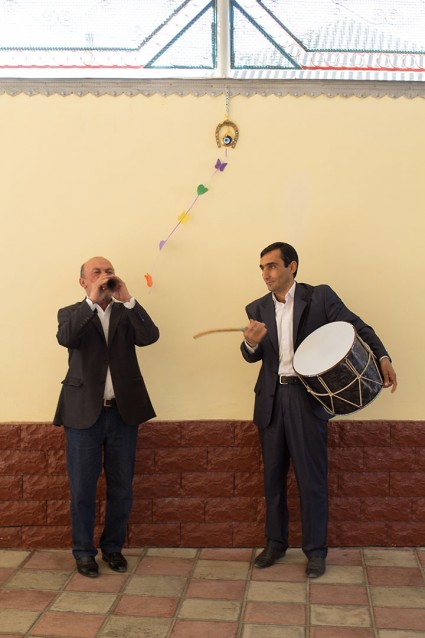 Musicians play outside the bride’s home as they wait for the groom to escort her out. Photo: Tom Marsden
Musicians play outside the bride’s home as they wait for the groom to escort her out. Photo: Tom Marsden
When they walk in the door amidst applause (and often through a gauntlet of pyrotechnic candles!), they are led to stand behind a small central table. Here they each give one-word verbal consent to their marriage and sign the city registration book as the equivalent of a justice of the peace looks on. If they have visited the city administrative office prior to the event, all they have left to do at this stage in the wedding is drink a toast (usually sparkling juice) with their single friends.
Then the couple enjoys a first dance before they are seated at the head table, where they will stay for the remainder of the evening while guests queue up to take pictures with them.
7. Save room for the ash
the waiters seem to be trained not to let a guest touch anything on the table
After the couple is seated, eating begins in earnest. Waiters bring rounds of hot dishes one after another. The cuisine is noticeably meaty: cold chicken and sausage pieces for starters are followed by beef stew, ribs, chicken kebabs, lule kebabs (made by squeezing ground lamb meat and ground tail fat onto a skewer) and, depending on the region of the country, baked fish.
The waiters seem to be trained not to let a guest touch anything on the table – if you begin to serve yourself a salad, for example, a waiter will rush over with a scornful look, snatch it from your hand and scoop it onto your plate. I’ve also learned the hard way that whatever you ask the waiter to pour into your glass at the beginning of the dinner, you’d better like, because he will automatically refill it every time you take a sip through the night.
After several hours of eating and dancing, the lights are dimmed again to announce a key moment in the event: the arrival of the ash (rice pilaf), the crowning main course to round out the meal. This is served with a flaming wad of cotton on top for effect. At many weddings the bride and groom are served their ash portion by a dancer in national dress who sways her way to the main table, deposits the fiery payload, and then entertains the guests with a flowing national dance on her way out. At the wedding in Qazakh, the ash was brought into the room by waiters pushing a bejewelled trolley like bellhops.
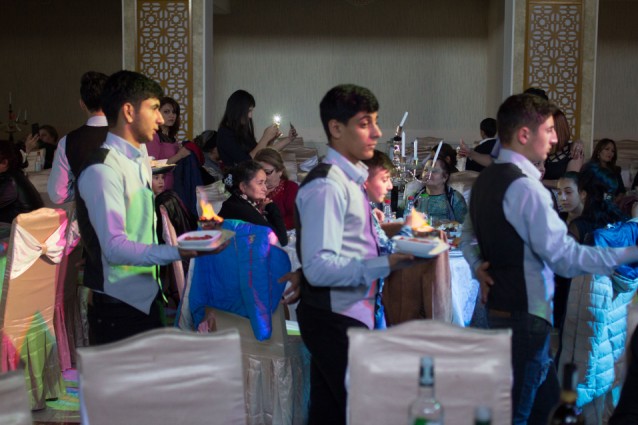 Waiters ceremonially bring in flaming dishes of ash, the much-anticipated final course of the meal. Photo: Tom Marsden
Waiters ceremonially bring in flaming dishes of ash, the much-anticipated final course of the meal. Photo: Tom Marsden
8. Don’t expect a ceremony
I used to think weddings here were remarkably ceremony-less. The Western world sees a wedding as a legal procedure: vows are said; rings are exchanged; a couple is declared man and wife by the court and often by the church. But in the more Eastern-leaning world of honour and relational capital, the community recognition of the wedding is what really seals it. If a marriage is publically witnessed, accepted and blessed, then it is official.
Throughout the event, the main action taking place on the stage and dance floor is a cycle of toasts and dances in honour of the couple. After each toast is given as a blessing over the union, the band plays a song, and the person who spoke does a dance (usually together with his/her family, as visual acknowledgment of the community’s happiness). This stream of verbal and visual blessings forms the main structural element of the wedding.
Families almost always videotape the entire event. The video not only covers the main stage but also each guest sitting at tables. This can be awkward as people pretend to stop chewing while the camera pans by. The families watch these multiple-hour-long cassettes repeatedly when they gather in the later months.
9. Dance with abandon, but watch your feet
The music is too loud to hear anyone but the person with the microphone, so most of the communication at weddings takes place not through table conversations but via the movements on the dance floor. People beckon for one another to come join in. They sway in small clusters, the women floating around gracefully and twisting their hands as if showing off their rings while men make bolder marching steps and straight arm movements like warriors shooting arrows. Eventually the two families blend together into a long, unified line where everyone links pinkies in a grapevine-style dance called yalli.
I wish I could teach you from my mistakes in this area too, but you’ll probably have to fumble around on the dance floor like I did. The only advice I can offer here is this: copy the movements of the people around you, smile like you don’t know you’re being projected onto the big screens around the room, and watch out for slippery things like crushed olives on the floor. Once I saw a bride herself go heels up over a pickled plum.
The dances wouldn’t happen without the live musicians stirring them on. Sometimes the musicians play percussion rhythms for young men to demonstrate their dexterity. When this happens the crowd presses in around a circle of youth who take the centre stage one or two at a time, chins out and arms high as their feet fly into a blur beneath them. They communicate with the musicians in gestures and glances. The drummer will often follow the dancers’ feet, and the overall pulse gradually speeds up into a sweaty frenzy.
10. Beware of matchmaking mothers
In Qazakh, I found myself in the middle of a knot of women, hands raised and gold jewellery flashing, twisting to the rhythms of a song about mothers-in-law. One rosy-cheeked woman in particular had her eye on me, and she visibly laughed when I winked and gestured with the heel of my palm towards her in rebellious daughter-in-law style in the dance. She was clearly enjoying the idea of setting me up with her bachelor son, so I let the joke linger.
This wasn’t the first time I’ve met mother-in-law hopefuls at a wedding. These events, after all, are one of the main opportunities for village people to mingle with other families and inspect their daughters, all coy behind their mascara and salon curls. It is not at all unusual that a young man (or his mother) takes notice of a young lady at a wedding, asks around to find out who she is, and begins the process of elchilik (sending a family messenger to inquire about the feasibility of arranging a marriage), thus beginning the wedding cycle over again for a new couple.
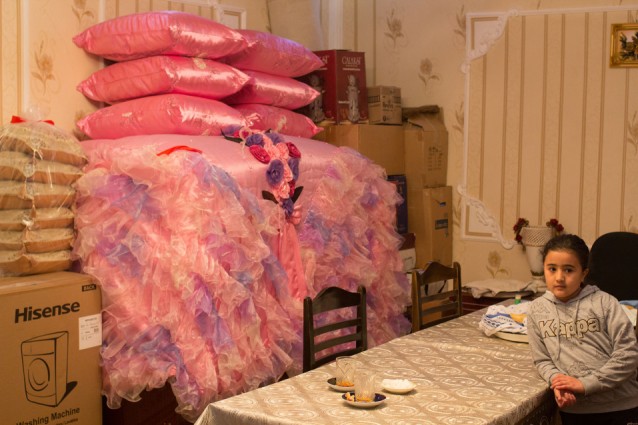
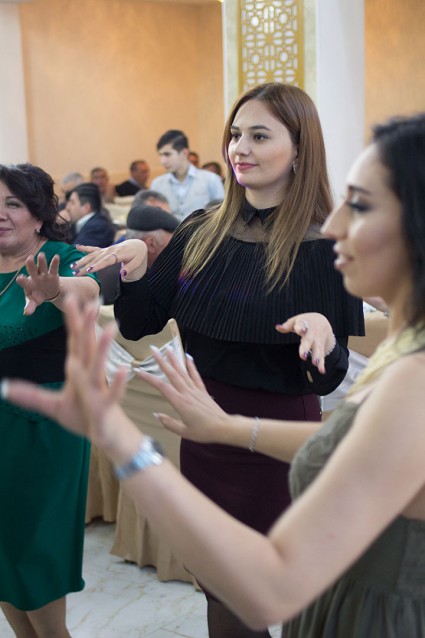


.jpg)